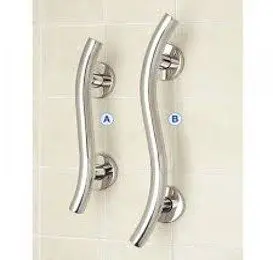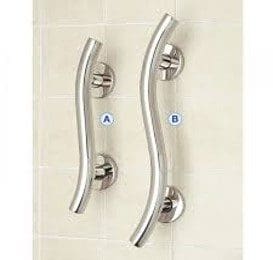What you never knew about grab bars!
Grab bars. Two simple words that one may assume describes a common solution to stabilizing a body position movement. While that is still true, the solutions to that stability have drastically changed in the last decade.
What I find interesting is how little most people actually know about the “realm” of grab bars. For instance, I have clients who may need them, but say they don’t want them installed because they are fearful they will be seen as “old” people. This tells me they have not seen how this former “tube” has changed dramatically, not only in form and function, but in location and style!
One of my first blogs was titled, “When I say grab bar, do you think sexy?” When I would say this at presentations, I would get a lot of chuckles. But when I showed images of the gorgeous options, the audience clearly saw my point.


First and foremost is deciding why a stability bar may be needed. (In some areas they are called rails, not bars.) Although most are commonly installed in the bathroom, there are other locations in a home as well that grab bars are useful.
The next decision is determining if the wall the bar is to be installed on has appropriate blocking or is on a framed wall. Older homes, such as those with wooden lath and plaster, make installation challenging and should definitely be done by a professional. Problems can also occur when installing bars on newer homes that have standard wall stud construction. Where the bar is to be installed may not be over a wooden stud, so again professional installation is needed. Some contractors have finally caught on to the need for this type of safety in the bathroom and have included blocking with new construction. (For example wood 2” x 4” boards mounted horizontally between two wall studs.)
The person needing a bar should position themselves in the situation where stability is needed. Then reach in whatever direction necessary to determine the location best suited for the bar. That does not mean that the location fits the criteria for installation! Ensuring the location provides all of the benchmarks for mounting the bar is crucial for the safety of the user.


Once a proper, acceptable location is determined, then comes the fun part. Choosing the style, finish, color and dimension of the desired grab bar. This has to match the planned location, however!
There are some caveats. I once toured an open house home built by a contractor who advertised this home as being “age in place friendly.” When I entered the bathroom, I was thunderstruck and demonstrated the issue to the builder. The grab bar he had installed in the bathroom was on the opposite wall of a toilet. But to use it, one had to rise off of the toilet and take a step forward! So ensuring the bar is in the correct location is obviously critical! And without question, the grab bars that use suction cups for adhesion to surfaces are dangerous as they can lose that suction without warning.
To give you an idea of the scope of available products, here are some examples:
- The first use of grab bars was most likely in hospital-type settings where patient safety was paramount.
- Vertical grab bars may help with balance while standing. Horizontal grab bars provide assistance when sitting or rising, or to grab onto in case of a slip or fall. Some grab bars can be installed at an angle, depending on the needs of the user and the positioning. These are particularly useful in situations where full body support or weight transfer is required
- Swing/flip up and down grab bars are used extensively in the bathroom as they can solve a myriad of balance issues.
- Grab bars that have both a straight and 45° or 90° angled bend to them, allow for stability in different body positions.
- There are now grab bars with LED lights that are sound-activated and glow-in-the-dark bars, which can help those who are vision impaired.
- Multi-functional towel or toilet roll holders, shelves and one specifically designed as part of a tub faucet, as well as many other stylistic options are available.
Recognize that it is not only seniors who may desire grab bars, but women who are pregnant, those with macular degeneration or other vision issues, balance problems from a Stroke or inner ear problems, any disease affecting muscle strength and/or stability or anyone with an impairment where the body is not working properly. There are grab bars for special needs strollers. Grab bar use is ubiquitous!


The Americans with Disabilities Act Accessible Guidelines (ADAAG) have specific standards for grab bar installation and is an incredible resource for such information. Although applicable to public buildings only, it is a very useful guideline for a wide variety of accessibility items, as well as a myriad of standards for doorway widths, toilet height, etc.
Grab bars have become, in many residences, a part of the home’s décor as their design and function have changed drastically in the past few years. Consider this if the time has come to create a safety option in your, your parent’s or a client’s home. Safety first – but with style!
Note: There are a vast number of ways that installation of safety products can be funded. They involve government, state and local organizations, charities and social service agencies. DO NOT let issues on funding prevent installation of such products!
Source: SilverSpacesBlog.com

























